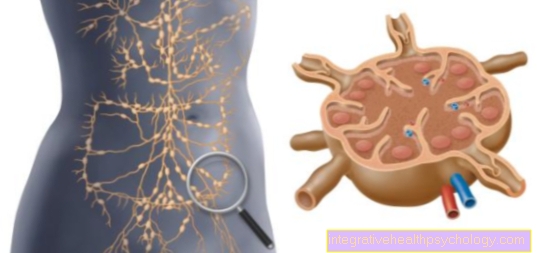Norepinephrine
definition
Noradrenaline is an endogenous messenger substance (Transmitter), which belongs to the subgroup of Katocholamines. It is made from the neurotransmitter dopamine with the participation of an enzyme (dopamine beta-hydroxylase). That is why dopamine is also referred to as the precursor of noradrenaline. Production takes place primarily in the adrenal medulla, but also in the central nervous system and specialized nerve fibers. In the adrenal gland, the chemically related catecholamine adrenaline is also produced from dopamine.
For more information on catecholamines, read the following articles: Dopamine, adrenaline and Catecholamines

Norepinephrine is involved in the regulation of various functional systems in the body. The control of the cardiovascular functions should be emphasized here. As a result, norepinephrine is regularly used in emergency medicine, for example because it has a strong vasoconstrictor effect or increases the heart rate and is therefore used to stabilize the circulation.
Lack of norepinephrine

In addition to its effects on the heart and blood vessels, norepinephrine influences subjective factors such as alertness, concentration and motivation. A waste or lack of this messenger substance has a negative effect on them. The situation is similar with regard to the formation of new memories in the memory.
Furthermore, connections between a norepinephrine deficiency and the development of depression could be established. This manifests itself in the established, drug therapy with antidepressants, which inhibit the reuptake of norepinephrine in the nerve cells (SNRI = Selective norepinephrine reuptake inhibitors and SSNRI = Selective Serotonin and Noradrenaline Reuptake Inhibitors). As a result, the available amount of noradrenaline remains longer in the space between two nerve cells and can thus increasingly bind to the specific receptors present. The binding causes different biochemical reactions in the corresponding cell, which in this case leads to an improved mood. In addition, the success of the therapy is expressed in an increased, motivational drive of the person concerned.
Read more on this topic: The role of serotonin / neurotransmitters in depression
A chronic, pathological deficiency of noradrenaline can be caused by a relatively rare metabolic disease. This is the so-called dopamine-beta-hydroxylase deficiency, which manifests itself in a lack of synthesis of noradrenaline from dopamine. Characteristically, the dopamine level in the blood plasma is increased, whereas the detectable amount of noradrenaline is decreased due to the low synthesis. Therapeutically, another precursor of noradrenaline is administered, which can be converted to noradrenaline without the involvement of dopamine beta-hydroxylase. The most important side effect can be an increase in blood pressure.
Norepinephrine receptors
The specific receptors for norepinephrine and adrenaline are called adrenoceptors. The two messenger substances act on two different receptor subtypes. On the one hand, the alpha receptors are stimulated and, on the other hand, the beta receptors are activated.
Alpha-1 receptors are mostly located on the walls of the blood vessels, which ensure the supply of the kidneys and the gastrointestinal tract. If these receptors are stimulated, this causes a narrowing of the blood vessels (Vasoconstriction), which results in an increase in arterial blood pressure.
Beta-1 receptors are found on the heart; their activation leads to an increase in heart strength and an increase in heart rate. In addition, the conduction of the electrical excitation within the heart, which leads to the contraction of the muscle cells, is improved. These effects together result in more efficient cardiac activity.
The blood vessels in the gastrointestinal tract express mainly beta-2 receptors, which when activated lead to an expansion of the vessels (Vasodilation) and thus improves the blood flow to the organs.
The receptors are also found in the bronchi, where there is an increase in diameter (Bronchodilation) cause.
Increased norepinephrine levels
To evaluate the individual norepinephrine level, its amount in the patient's urine is determined. For this purpose, the patient first collects his urine excreted over 24 hours, which is used entirely for the measurement. The results are interpreted in relation to the known reference values. For a healthy adult, these are in the range between 23-105 µg or 135-620 nmol per day.
An increased excretion of noradrenaline indicates an increase in the noradrenaline level in the blood, which can be caused by various causes.
On the one hand, this can be the result of a hormone-producing tumor of the adrenal medulla, a pheochromocytoma. These are benign in 85% of cases and mostly produce uncontrolled noradrenaline and adrenaline, and rarely dopamine.
Furthermore, a neuroblastoma, a malignant tumor of the nerve cells of the adrenergic system, can lead to an increased production of catecholamines.
The more common causes of increased norepinephrine levels include high blood pressure and long-term stress, although no differences can be determined between psychological stress and excessive physical exertion. However, this stress-related increase in catecholamines is not permanently tolerated by the body, which manifests itself in a feeling of physical exhaustion.
dosage
Since noradrenaline causes its effects in the body even in small amounts, an exact dosage is of decisive importance in the context of therapeutic use in intensive medicine. A particularly rapid effect is achieved by administering a certain dose as part of a single dose (Bolus) obtained intravenously. The stable development of the desired effects is guaranteed by the continuous infusion of smaller doses using a perfusor pump. For adults, a dose of 0.01-1.0 µg / kg body weight / min is usually administered. The individual dosage of the patient is adjusted based on the clinical course.





























